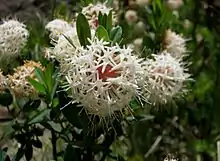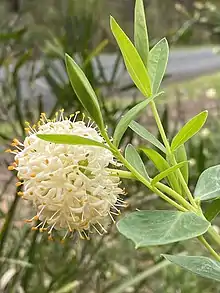Pimelea ligustrina
Pimelea ligustrina, commonly known as tall rice-flower, is a shrub species in the family Thymelaeaceae. It is endemic to south-eastern Australia.[2]
| Pimelea ligustrina | |
|---|---|
 | |
| Pimelea ligustrina subsp. ciliata | |
| Scientific classification | |
| Kingdom: | Plantae |
| Clade: | Tracheophytes |
| Clade: | Angiosperms |
| Clade: | Eudicots |
| Clade: | Rosids |
| Order: | Malvales |
| Family: | Thymelaeaceae |
| Genus: | Pimelea |
| Species: | P. ligustrina |
| Binomial name | |
| Pimelea ligustrina | |
| Synonyms | |
|
Banksia ligustrina (Labill.) Kuntze | |

Plants have an erect habit, growing to between 1 and 3 metres in height. Leaves are 15 to 90 mm long and 7 to 20 mm wide.[3] The flowers are clustered in groups, the heads surrounded by 4 or 8 bracts.[3] These are followed by green to red-brown fruit.[3]
The species was first formally described in 1805 by French naturalist Jacques Labillardière in Novae Hollandiae Plantarum Specimen.[1] Three subspecies are currently recognised:
- P. ligustrina subsp. ciliata
- P. ligustrina subsp. hypericina
- P. ligustrina subsp. ligustrina
It occurs in coastal areas and mountain ranges in Queensland, New South Wales, the Australian Capital Territory, Victoria, South Australia and Tasmania.[3] It is a food plant for caterpillars of the yellow-spot blue.[2]
References
- "Pimelea ligustrina". Australian Plant Name Index (APNI), IBIS database. Centre for Plant Biodiversity Research, Australian Government, Canberra. Retrieved 29 December 2012.
- Wild Plants of Victoria (database). Viridans Biological Databases & Department of Sustainability and Environment. 2009.
- "New South Wales Flora Online: Pimelea ligustrina". Royal Botanic Gardens & Domain Trust, Sydney, Australia.